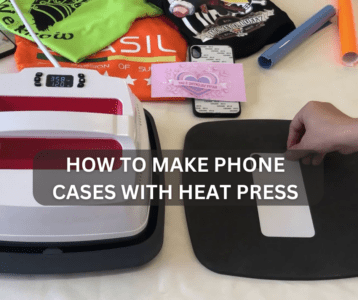Do you want to make your own phone cases? Are you interested in how to make heat press phone cases? If so, then this article is for you. In this article, we will explore the basics of how to make personalized heat press phone cases. We will cover the materials and tools needed to get started and tips and tricks for successful creation.
Making your own custom phone cases is a great way to express yourself and show off your unique style. With the help of a heat press, it’s possible to make professional-looking cases from the comfort of your home.
We all want our phones to look stylish and unique, but buying expensive cases can be a hassle. Heat press phone cases are a great way to customize and personalize your device without breaking the bank. With heat press technology, you can quickly and easily make custom designs that will last for years.
Let’s get started on how to make heat press phone cases and some useful tips.
How To Make Heat Press Phone Cases
In today’s world, technology is ever-evolving, and so is fashion. People want to accessorize their phones with cases that protect them and reflect their individual sense of style. Heat press phone cases are a great way to customize your phone in a fun and creative way.
Here we will look at how to make heat press phone cases, so you can have a unique case for your device all year round.
1. Materials Needed
With just a few simple materials and steps, you can have your own customized case in no time. First, you need the items that will be used to create the actual design for your case: the fabric of your choosing, an inkjet printer, sublimation paper, and ink cartridges. You will also need a heat press machine that can help seal the fabric and transfer the image onto it.
2. Creating the Design
For those wanting to create their own heat press phone cases, having a good grasp of graphics software is essential. Using simpler programs like Adobe Photoshop Elements or Corel Draw are great choices as they provide basic drawing and photo editing functions, which allow users to quickly come up with a design they can be proud of.
3. Set Temperature & Time
Heat presses work by applying a combination of pressure and heat from the heating plate in order to transfer a design onto an item such as a phone case. The settings must be accurate in order for the design to stick correctly and prevent any damage from being done. Before beginning the process, it’s important that you read through all instructions regarding heat settings and time frames so that your finished product looks professional.
4. Place Artwork
You will learn about two ways to transfer the artwork onto their phone cases: paper and vinyl.
1. Transfer Paper
Transfer paper is a great option for those looking for a quick, cost-effective way to transfer the artwork onto their phone case. This type of paper allows you to simply print out your desired image using your home printer and then apply a heat press machine directly onto the phone case.
2. Vinyl
Vinyl may be the better choice for those looking for something more durable. Vinyl transfers are simpler than they sound; all you need is vinyl material printed with your desired design and sometimes a heat press machine to adhere the design onto your phone case’s surface.
5. Press & Peel
The process of making the phone case is simple. First, use the craft iron to apply heat to the heat transfer paper for about 20 seconds on each side. Then carefully peel off the backing from the paper and place it onto your chosen phone case surface so that it sticks properly. Press down hard with an old cloth or press cloth to ensure maximum sticking power before cutting out any superfluous edges that might be visible through the design.
6. Add Adhesive & Case
Once you’ve finished designing your case and it’s ready for printing, there are just two final steps – adhering the printed design to its backing using adhesive and then adding your case to a hard shell for protection.
The adhesive is essential in this process since it provides stability for the print on the backing material. You can use liquid or spray adhesive, depending on what kind of material you’re working with – some materials may require specific types of adhesive. Make sure to carefully read all instructions before applying the adhesive in order to get the best results possible.
Tips and tricks for successful creation
Creating beautiful and stylish phone cases with a heat press is easy to show off your artistic skills and make some extra money. With the right tools, knowledge, and determination, you can easily create high-quality phone cases that will stand out amongst the competition. Here are some tips and tricks for successfully creating heat press phone cases.
-
- The first step to creating a successful design is to plan ahead.
- Think about what colors you want to use, how many layers you need, or if any special materials are needed for the project.
- Once you have an idea in mind, creating a design that will fit your vision will be easy.
- When creating your design, it is important to remember that the phone case will not be able to be as detailed as a piece of apparel or art on clothing.
- The phone case has limited space to work with. You will want to use simple designs and colors that will still be eye-catching.
Conclusion
The conclusion of this article on how to make heat press phone cases is simple: anyone can take the time to learn and create these beautiful custom cases. With a few basic tools, creativity, and the right instructions, you can easily make your own heat press phone case. Not only will you have fun doing it, but you’ll also be able to express yourself through a unique design that reflects your personality and style.
Heat-pressing phone cases are an excellent way to show off your creative side while also protecting your device from everyday wear and tear. With just a little bit of know-how, you can customize any case in no time at all. Don’t forget to browse for inspiration or even experiment with different colors and patterns for something truly unique.

I’m Henry Collins and living my happy life. I’m a professional businessman and I own and run 6 Heat Pressing Services stores where I provide my clients with custom Designs on hats, mugs, T-Shirts and a lot more using Heat Press Machine. Been using a heat press for the last 4 years and people love my work. As I’ve got enough information on Heat Press I decided to make a blog on it and share my knowledge with the world. I hope, the world will appreciate it.

